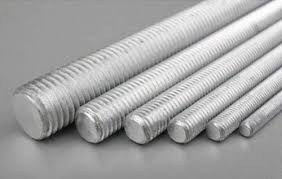
Galvanized threaded rods are used in various industries and for projects that require more stability or durability. You likely have many questions if you’re thinking of using galvanized threaded rods when building your own house.
This article will answer the most common FAQs.
What is Galvanizing?
Galvanizing, or galvanization, is a manufacturing process where a zinc coating is applied to iron or steel to offer better protection and resist rusting. The most common galvanizing process is called “hot-dip” galvanizing, but some manufacturers will use thermal diffusion.
Galvanized steel is a popular steel type because the galvanization process extends the overall durability of regular steel. Zinc acts as a protective barrier against corrosive elements. Due to its versatility, galvanized steel is used in several industries, such as construction and agriculture.
Does Galvanizing Make Steel Rust Proof?
Although galvanized steel is rust-resistant, it isn’t rust-proof. Galvanized steel in a wet or soaked environment will last 10 years or 34 years in conditions with a relative humidity of 100%. But most builders would use nylon in these conditions, as it’s non-corrosive and more cost-effective.
Galvanized steel works best in relative humidity below 60%, where the zinc layer won’t be consumed for 211 years. However, this assumes that the zinc coating is thick.
What are Threaded Rods?
Threaded rods are used to pin or fasten two materials together. Threaded rods are commonly used to stabilize structures or other objects in the ceiling or wall. In some cases, builders would use a threaded rod if they can’t pin or stabilize structures with the longest screw or bolt.
Threaded rods go by five other names: threaded stud, threaded bar, all-thread, all-thread rod, or screw rod, but they all describe the same thing. Most threaded rods have a helical structure, which is rotated during installation. This rotational movement will resist pressure.
What are Galvanizing Threaded Rods Used For?
Galvanized threaded rods are primarily used in structural and non-structural construction, plumbing and contracting, HVAC installation, metalworking, machinery, and oil and gas.
Contracting and plumbing rely on threaded rods made of steel because they typically work with residential or commercial builds. HVAC installers often need galvanized threaded rods to enable quick level installation or sloping installation of heaters, air handlers, and ductwork.
Galvanized threaded rods may also hang suspended ceilings when they require proper alignment. You’ll also find them in medical and manufacturing machines.
What is the Difference Between a Threaded Rod and Bolt?
A threaded rod and bolt are similar. However, a bolt has a head and is threaded on one end, whereas a rod is threaded on both ends. Bolts are typically much shorter than rods at a few inches long. If you want to make a short threaded rod, you can cut it down using the equipment.
Can You Galvanize High Strength Bolts?
Certain high-strength bolts like F1554g55 and ASTM A572g50 low alloy steels can be galvanised. Medium carbon steel that’s been quenched and tempered, such as ASTM A449, can also be galvanized. However, things get tricky when we move to medium carbon alloy steel.
When a high-strength bolt is made of medium carbon alloy steel (quenched and tempered), it’s more likely to be susceptible to hydrogen embrittlement and shouldn’t be hot-dip galvanized.
What Types of Threaded Rods are Available?
There are five common types of commercially available threaded rods. These include:
-
Fully Threaded Rods
A fully threaded rod has threads that run the entire length of the rod. These are used for walls and ceilings or sometimes as screws or bolts.
-
Double-Sided Threaded Rods
A double-sided threaded rod has threaded ends and a non-threaded middle. Both ends are secured with nuts. These are used for doors.
-
Tap-End Studs
A tap-end stud looks like a double-sided threaded rod, but one side is longer. The shorter side has a chamfered point. These are used on cars.
-
Internally Threaded Rod
An internally threaded rod provides a secure joint for another threaded rod. These are used in any industry that requires any type of threaded rod.
-
Hollow-Inside Threaded Rod
A hollow-inside threaded rod looks similar to a fully threaded rod, except it’s hollow for wires to pass through. These are used in homes.
If you’re building a home, you will use fully threaded, double-sided, and hollow-inside threaded rods. As threaded roads are often cut in one-meter lengths, you may need a custom length for some projects. A cold cutting blade can provide a much quicker finish.
What Do the Color Codes Mean on Galvanized Threaded Rods?
Threaded rods are often colour coded on one end. These colours indicate the rod’s strength, with white being the strongest. As these colour codes are defined by the International Organization for Standardization (ISO), you can trust that a reputable supplier will code each piece properly.
Galvanized threaded rods belong to property classes 4.8 and 8.8 and are light blue, orange, steel grey, or purple. Out of the galvanized variety, purple and steel grey is the strongest.




 POSTED BY
POSTED BY 

